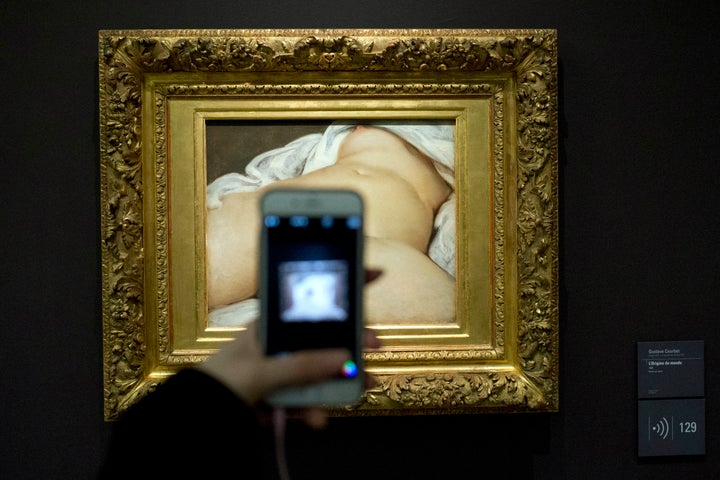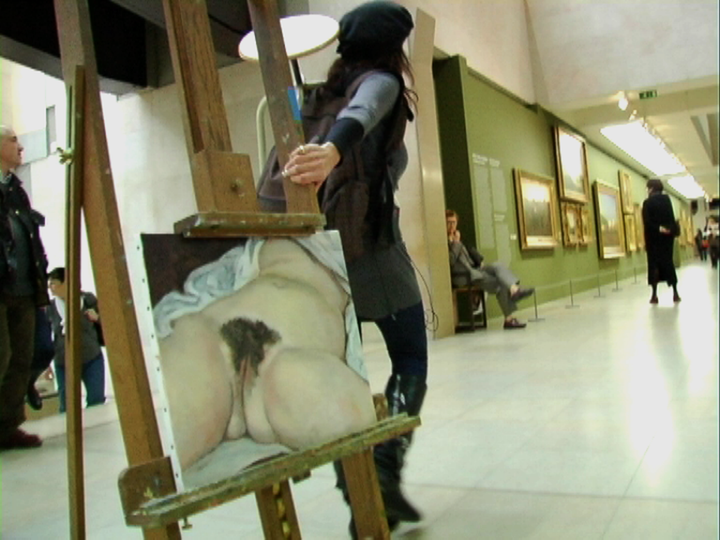
I knew that staring was rude. But it was hard not to stare at the realistically rendered, X-rated perspective of a splayed vagina on view in one of the most celebrated museums in the world. No face, no legs, no arms, just ladybits. Not a fig leaf in sight. I wasn’t the only voyeur, mind you. People were milling about, snickering or averting their gaze once their brains registered what they were looking at.
It was the winter of 2011. I had just arrived in Paris on an extended artist residency and was visiting the d’Orsay Museum to get the creative juices flowing. From the moment I laid eyes on Gustave Courbet’s sensational 19th century masterpiece, “The Origin of the World” (“L’Origine du monde”), I was smitten. The audacity, the beauty, the fearlessness of it! Even as I continued my trek through the museum admiring the van Goghs, the Monets and the Manets, the searing afterimage of Courbet’s vulvic portrait lingered on.
(Note: This article includes photographs and video of Courbet’s painting, so if that’s not something you feel comfortable looking at, don’t read any further.)
After several hours of art gazing, I decided to call it a day. What transpired next is still something of a mystery. As I was heading toward the museum exit, my feet made a sudden beeline for the information desk. Elbowing my way through the throng, I asked the sultry mademoiselle behind the counter how one goes about getting permission to copy one of the museum’s masterpieces. I don’t know what possessed me. I had never attempted, nor been tempted, to copy another artist’s work ― let alone in public where one’s creative shortcomings might be all too evident. Raising one perfectly groomed eyebrow she inquired as to which painting “madame” was interested in copying. “L’Origine du monde!” I blurted out.
I had come to Paris with a vague notion of exploring the topic of female sexuality and aging. Despite joining that broad swath of women of “a certain age,” I felt at the peak of my sexual prowess and was having a hard time coming to grips with the looming prospect of diminishing sexual appeal. What better place than Paris to hunt down the elusive essence of enduring feminine allure? It’s no secret that French men still wax lyrical about octogenarian sex kitten Brigitte Bardot, and Napoleon himself remarked, “Give a woman six months in Paris, and she knows where her empire is, and what is her due.” But where to begin? “The Origin of the World” seemed as good a starting point as any.
The young woman behind the information counter regarded me with renewed interest. “L’Origine du monde” had only made its first public debut 15 years earlier, and was one of the museum’s prized possessions. I was the first artist to request permission to copy it. After directing a group of visitors toward the toilettes, she condescended to outline the copyist application process. Obtaining a permit turns out to be harder than biting into the heel of a stale baguette. Not to be deterred, I appealed directly to the head of the copyist department as if my life depended upon copying Courbet’s masterpiece ― a painting that had barely registered on my radar until that day. It’s amazing what sheer determination, luck, and a bit of chutzpah can achieve.
One week later, I was looking at my stunned face laminated onto an official copiste ID badge. I now had access to the copyist storeroom situated in the bowels of the museum. I selected a worn, paint-encrusted easel and stool that I was to pick up each morning after signing in at the employee entrance, and return no later than one o’clock. No exceptions! I had to provide a canvas that was 15% smaller or larger than Courbet’s original (to thwart any possibility of forgery), plus my own painting paraphernalia.
Every morning over the next six weeks, I set up my mini studio in the Courbet gallery while a continuous roster of international visitors watched me paint every fold, crevice and pubic hair of the most famous vagina in the world (I’m unaware of any other that can boast over a million visitors a year and regularly makes the headlines 150 years after it was conceived). The first day was traumatic. Who was it that said life begins at the end of your comfort zone? It felt more like being blasted out of my comfort zone and into the ozone. I remember blushing a lot. My hands shook and my confidence wilted under the gaze of a stone-faced museum guard who watched as I made my first mark on a virgin canvas.
Six weeks may seem like enough time to copy one painting. But in actual fact it was a race against the clock ― drawing, underpainting, color balance, glazing, and reworking are not only time consuming but painstaking. Aside from the painting challenge and the performance art aspects of my task, being “L’Origine du monde’s” copyist was also an immersion into the human psyche’s ambiguous relation to a woman’s sex.

The sight of a mature woman reproducing a painting of a vagina impelled total strangers to confess their most intimate thoughts and feelings. Henry David Thoreau once said that it’s not what you look at that matters, it’s what you see. There was the older gentleman with tears in his eyes who spoke of the poignant memory “L’Origine” triggered of standing over his mother’s body at the funeral home and succumbing to an irresistible urge to caress her inner thigh in loving gratitude. A young Spanish artist shared a painting of her own genitals, a tribute to what she saw as the ultimate source of joy and pain. A journalist living in Paris claimed that any man who denied that the painting made him want to fuck it would be lying. An American couple thought it inappropriate for public consumption, and a group of young women were turned off by the thick pelt of pubic hair. This baffled me. What did they think their manicured cooches would look like without a monthly waxing?
Even in our jaded times Courbet’s unapologetic portrayal of a vagina continues to shock, terrify, repel and delight. It forces the viewer to confront his or her deeply rooted sexual, religious, aesthetic and moral positions. Is it sacred or profane? Beautiful or repulsive? Threatening or empowering? As the symbol of life itself, under whose jurisdiction does it lie? Unfortunately, the debate still rages today and women in this country must continue to fight for the right to control our own bodies.
As my stint at the museum was coming to a close, I felt as if “The Origin” and I had become one and the same ― stripped and exposed, yet oddly empowered. Copying the vulvic image became a meditative experience. Pride replaced my original embarrassment. In her book “Vagina,” Naomi Wolf asserts that “the vagina is part of the female brain,” directly correlating to female creativity and confidence. I experienced newfound feelings of limitless possibilities. I embraced new opportunities. I took risks with my work. And when I sashayed down the boulevards in my high-heeled boots, I returned the appreciative male glances with a knowing smile.

After completing my authorized copy and having it approved by the head of the museum’s copyist department (“Bravo!”) I was free to take it home. That was far from the end of my journey with “The Origin of the World,” however. Reading up on the painting’s history, I discovered a secret past as remarkable as its flagrant nakedness. I spent a good portion of the next seven years penning my newly agented manuscript, ”L’Origine,” inspired by the painting’s astonishing odyssey and the eccentric cast of characters whose paths it crossed. Who would have thought that a serendipitous encounter with Gustave Courbet’s 19th century masterpiece would turn into one of the most enlightening and rewarding experiences of my life?
Paris-born Lilianne Milgrom holds dual U.S. and Australian citizenship. She is an award-winning artist, blogger and published writer on the arts. She holds two graduate degrees from Melbourne University and an associate art degree from the Academy of Art in San Francisco. She lives in the greater Washington, D.C., area with her husband. Her children are grown and exploring the world, each in their own way. For more information about Lilianne, or to contact her regarding her book, visit her website, http://www.liliannemilgrom.com. You can also follow her on Instagram.
Do you have a compelling personal story you’d like to see published on HuffPost? Find out what we’re looking for here and send us a pitch!
HuffPost’s “Her Stories” newsletter brings you even more reporting from around the world on the important issues affecting women. Sign up for it here.
